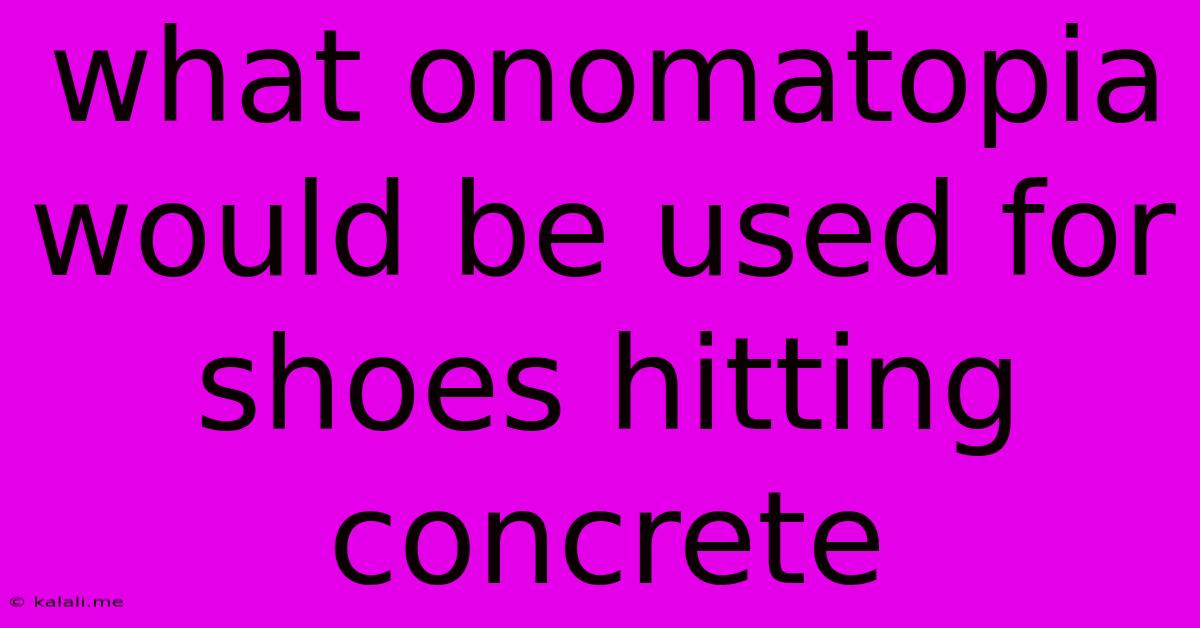What Onomatopia Would Be Used For Shoes Hitting Concrete
Kalali
Jun 08, 2025 · 3 min read

Table of Contents
The Sonic Landscape of Shoes on Concrete: A Guide to Onomatopoeia
The simple act of shoes hitting concrete generates a surprisingly rich soundscape, varying dramatically depending on the type of shoe, the surface, and the force of the impact. Capturing this sonic complexity requires a nuanced approach to onomatopoeia, the use of words that imitate sounds. This article delves into the various onomatopoeic possibilities, exploring the subtle differences in sound and the best words to evoke the specific feeling you want to convey.
Choosing the right onomatopoeia depends heavily on the context. Are we talking about a light tap, a heavy thud, a rhythmic pounding, or the screech of a skid? Let's break down the different scenarios and the most fitting words:
Light Steps: The Subtle Sounds of Movement
For a light, almost silent footstep, words like tap, tap-tap, pat, pitter-patter, or even a soft click might suffice. These evoke a sense of quiet movement, perhaps someone walking softly or in socks. These sounds are often used to describe a gentle, delicate gait. Think of a ballerina's light steps across a stage, or a child tiptoeing.
Medium Impact: The Everyday Sounds of Walking
The most common scenario involves the everyday sound of walking. Here, the onomatopoeia needs to capture a more substantial sound, but still remain relatively neutral. Words like thump, thump-thump, thud, clomp, or clack become appropriate. The choice depends on the type of shoe. Heavier shoes, like boots, might call for clomp or thud, while lighter shoes might warrant thump or clack. The pace can also influence the choice: a fast pace might be represented by rapid repetition of thump-thump-thump, while a slow, deliberate pace might be indicated by a slower, more spaced-out thud... thud... thud.
Heavy Impact: The Forceful Sounds of Running or Jumping
For a heavier impact, such as running or jumping, words like boom, bang, thwack, smack, or even whack become relevant. These suggest a significant impact, and the intensity of the sound is directly related to the force of the impact. A powerful jump might be accompanied by a resounding boom, while a heavy object dropped might produce a sharp thwack. These words are often associated with a sense of force and power.
Skidding and Slipping: The Sounds of Loss of Control
When shoes skid or slip on concrete, the sound becomes considerably more dramatic. Words like screech, scrape, grind, scrabble accurately represent this loss of control. These sounds are harsh, grating, and usually associated with a sense of danger or urgency. The choice depends on the speed and intensity of the skid. A quick, short skid might use screech, while a longer, more prolonged skid might be best represented by scrape or grind.
Combining Onomatopoeia for Richer Descriptions
To create a truly evocative description, you can combine different onomatopoeic words, using them in a sequence to paint a vivid sonic picture. For instance, "The heavy boots thudded on the concrete, each clomp echoing in the empty street, until a sudden screech announced a near-miss."
By carefully considering the context, the type of shoe, and the force of the impact, you can select the most appropriate onomatopoeia to bring the sound of shoes on concrete to life in your writing. Remember that the best onomatopoeia is one that resonates with the reader and accurately conveys the intended feeling.
Latest Posts
Latest Posts
-
Match Any Character Including Newline Regex
Jun 08, 2025
-
Who Does God Speak To In The Bible
Jun 08, 2025
-
Why Does My Heater Smell Musty
Jun 08, 2025
-
How Long Will Refrigerator Stay Cold
Jun 08, 2025
-
What Is The Opposite Of Dense
Jun 08, 2025
Related Post
Thank you for visiting our website which covers about What Onomatopia Would Be Used For Shoes Hitting Concrete . We hope the information provided has been useful to you. Feel free to contact us if you have any questions or need further assistance. See you next time and don't miss to bookmark.